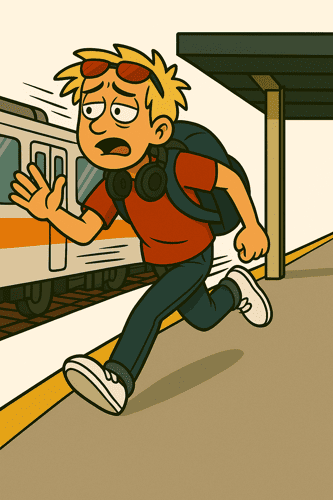
Japan is a relatively small country, which means you will likely find yourself taking the train quite often during your travels.
When riding trains in Japan, you may find that the etiquette differs from that of your home country.
What may be perfectly acceptable behavior on trains elsewhere can sometimes be considered a bit rude or problematic in Japan.
In this article, we will explore the rules of Japanese train etiquette through the lens of our traveler, RedHotRonnie.
This time, Ronnie is experiencing the Japanese train system for the first time.
Will he be able to navigate the rules and ride smoothly?
Let’s take a peek into Ronnie’s journey through Japan and see how he fares on the trains!
1. Train Etiquette Mistakes in Japan
1-1. Annoyance Level ★☆☆☆☆ (Mild – Situational)
Humans Aren’t Snails, Are They?
It’s Ronnie’s first time riding a train in Japan.
Feeling great and ready for adventure, he steps onto the train… but oops, his first little mishap happens right away.
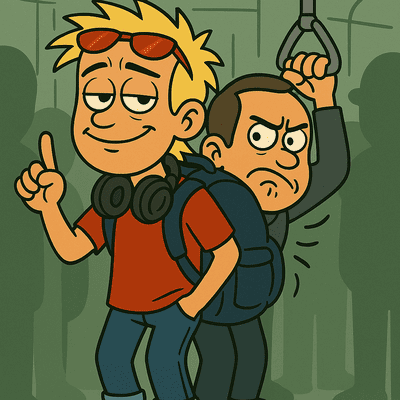
Manner #1: Don’t Wear Your Backpack on Your Back
In a crowded train, wearing your backpack on your back can be a nuisance to the people behind you.
It’s better to grab the handles and let the bag hang by your side, or place it on the overhead rack.
(If the train isn’t crowded, it’s usually not a problem unless you’re holding it in a very awkward way. In the past, wearing it on the front was considered the standard solution, but nowadays many people feel it doesn’t make much of a difference.)
Ronnie’s Comment:
My bag, on my back, so bad…?
Manly or Messy? Ain’t Classy
Ronnie is sitting comfortably on the train, spreading his legs wide.
But wait… is this really the way to sit?

Manner #2: Don’t Spread Your Legs Wide
When sitting on a train, especially if someone is next to you, avoid spreading your legs too wide.
It can come across as intimidating and might even cause unexpected trouble with the person next to you.
Ronnie’s Comment:
Instead of spreading wide, I’ll keep my manners by my side…
1-2. Annoyance Level ★★☆☆☆ (Moderate – Situational)
How Many People Are You?
Ronnie is planning his next destination and seems pretty excited.
But wait… why is his bag sitting while people are standing?
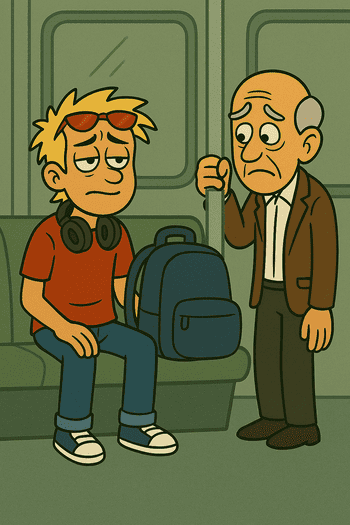
Manner #3: Don’t Put Your Bag on the Seat
If the train is crowded, or even starting to get crowded, it’s not okay to leave your bag on the seat.
That bag could be taking up space where someone else could sit.
Ronnie’s Comment:
I get tired, but my bag stays wired…
Is This a Dining Car?
Feeling a bit peckish before reaching his destination, Ronnie remembers the half-eaten burger in his bag.
Why not have a bite?
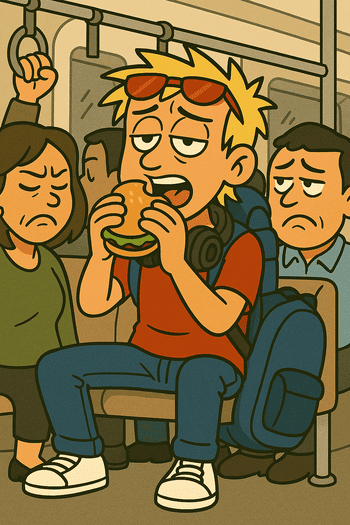
Manner #4: Avoid Eating on the Train
A train is a public space. Eating food with a strong smell or drinking alcohol can easily draw judgmental looks from other passengers.
On the other hand, small snacks like candy or chewing gum, or non-alcoholic drinks like bottled cola or tea, are generally not an issue as long as they don’t disturb others.
Ronnie’s Comment:
If you’re hungry, don’t make others angry…
1-3. Annoyance Level ★★★☆☆ (Somewhat Severe – Noticeably Annoying)
How Far Is Too Far?
Ronnie is sightseeing with a friend in Japan. They manage to find two seats, but they’re on opposite ends of the bench.
Still, it’s good to sit down, right? But wait…

Manner #5: Don’t Shout Across the Bench Seats
If you’re seated on opposite sides of a bench seat, avoid shouting across the aisle to communicate.
Speaking loudly from one end to the other can feel intimidating to others, especially in a quiet train.
If you need to chat, keep it brief and wait until you reach your destination to continue.
Ronnie’s Comment:
I’ve got so much to say, but I’ll save it for another day…
Sharing My Beats, Whether You Want Them or Not
Ronnie decides to listen to some music to pass the time.
But wait, why do people around him look a bit annoyed?

Manner #6: Be Mindful of Sound Leakage from Earphones/Headphones
Even if you’re enjoying your favorite song, the sound leaking from your headphones might just be noise to others.
Particularly in a crowded train, the people next to you have no escape from the intrusive sound.
Be mindful not to play your music too loudly.
Ronnie’s Comment:
My sound leakage, trapped in a cage, making others feel the rage…
1-4. Annoyance Level ★★★★☆ (Severe – Clearly Problematic)
Blocking the Way?
Ronnie is traveling with large luggage. Unsure where to place it, he decides to just…
Oops, it’s blocking the aisle!
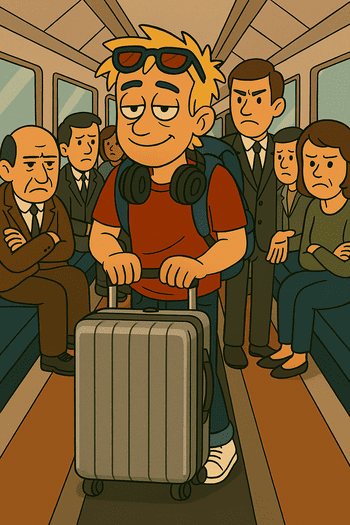
Manner #7: Don’t Block the Aisle with Your Luggage
Blocking the passage with your bags can prevent others from moving around or reaching the exit.
Especially during crowded times, it’s essential to keep the aisle clear by placing your luggage to the side.
Ronnie’s Comment:
Big bags, less space – not the smartest move in place…
The Call That Shook the Car
Ronnie decides to call a friend to discuss their next meetup spot.
With phone in hand, he starts chatting away, but…
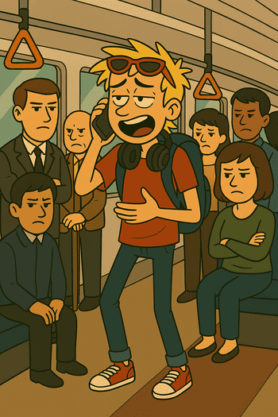
Manner #8: Don’t Make Loud Phone Calls
Talking on the phone in a quiet train can make others feel uncomfortable.
In Japan, phone calls on public transportation are generally considered a no-go, and speaking loudly only doubles the annoyance.
If absolutely necessary, keep it brief and speak quietly to minimize disruption.
Ronnie’s Comment:
Even when I’m on my own, I’ll leave that call for later on…
1-5. Annoyance Level ★★★★★ (Very Severe – Definitely Unacceptable)
Memories of the Journey
Ronnie wants to share his train experience on social media.
Perfect timing to whip out that selfie stick! Or is it…?
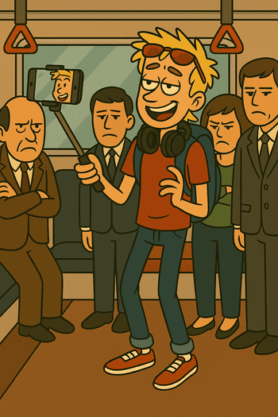
Manner #9: Don’t Take Photos or Videos Inside the Train
Taking pictures inside the train can invade other people’s privacy and might even be mistaken for illegal filming.
Using a selfie stick is especially problematic, as it can physically disturb or even harm other passengers.
Avoid filming or taking selfies on public transportation to prevent misunderstandings or trouble.
Ronnie’s Comment:
A selfie on the train? Man, I’m just too vain…
Saving the World with Music?
Feeling extra cheerful today, Ronnie decides to blast his favorite tunes on his portable speaker.
After all, music makes everything better… right?
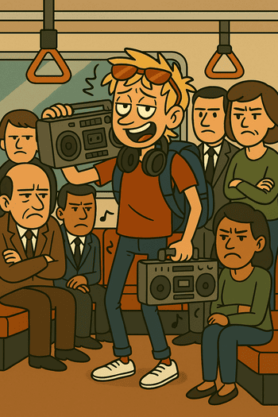
Manner #10: Don’t Play Music Out Loud
In Japan, no one plays loud music on public transportation.
If you do, people will likely think you’re out of your mind.
Using speakers in such a space is considered one of the most inconsiderate actions you can take.
Ronnie’s Comment:
Tunes so hype, but no one’s vibing right…
2. Conclusion
How was that?
For RedHotRonnie, many of these rules might have come as a surprise, but it seems like he’s managed to learn them after all.
There are quite a few etiquette rules to keep in mind when riding trains in Japan.
However, most of them follow the simple principle of “not bothering others.”
The challenge lies in understanding what Japanese people consider bothersome, as this perception can differ from other cultures.
In Japan, “being considerate” often means valuing quietness, personal space, and avoiding actions that might inconvenience others.
Once you grasp this basic mindset, navigating Japanese train etiquette might be easier than you think.
Instead of just viewing the train as a mode of transportation, why not see it as an opportunity to observe Japanese behavior?
It might help you feel a little closer to understanding the local way of life.
Have a great journey!
(And if you happen to meet RedHotRonnie on the train, tell him you enjoyed the article!)
You might also like:


